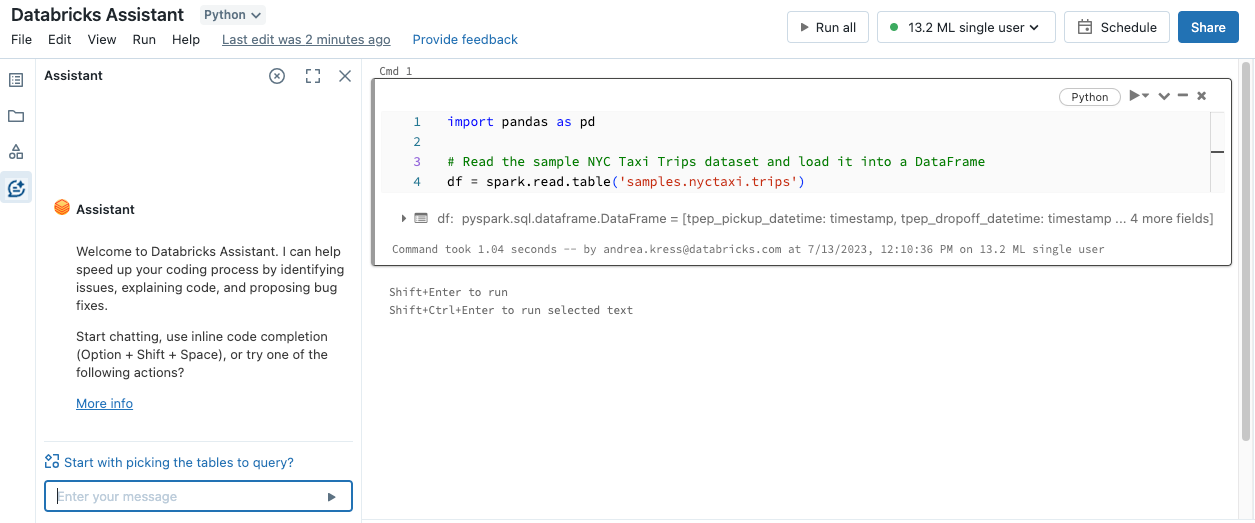Note
Access to this page requires authorization. You can try signing in or changing directories.
Access to this page requires authorization. You can try changing directories.
Databricks Assistant is an AI-based pair-programmer and support agent that makes you more efficient as you create notebooks, queries, dashboards, and files. It can help you rapidly answer questions by generating, optimizing, completing, explaining, and fixing code and queries.
This page provides general information about the Assistant. For questions about privacy, trust, and security, see Databricks AI assistive features trust and safety.
How can Databricks Assistant help?
Databricks Assistant is built with features that can help with the following tasks and more:
- Interact with the Assistant in various modes to get the help you need:
- Chat mode: Get answers to your questions by chatting with the Assistant. It responds with relevant information, including citations from Databricks documentation.
- Edit mode: Allow the Assistant to make suggestions across multiple cells in your notebook from a single prompt.
- Agent mode: Use the Data Science Agent (Beta) to automate entire multi-step data science workflows in notebooks and the SQL editor.
- In any mode, use /slash commands for common prompts.
- Get coding and debugging help with these Assistant features:
- Use command shortcuts to work with the Assistant directly in a notebook cell.
- Inline suggestions and autocomplete to help you write code.
- Quick fix that automatically suggests fixes for basic errors that you can choose to accept and run.
- Diagnose error, where the Assistant will analyze more complex errors, including environment errors, and attempt to fix them.
- Use the Assistant to diagnose errors in Jobs.
- Explore data with natural language:
- Use the Assistant to create data visualizations in AI/BI dashboards. Companion Genie spaces are automatically created with your dashboards, and you can use these Genie spaces to further analyze your data.
- Filter data with natural language prompts.
- Explore sample table data in Catalog Explorer.
Assistant uses Unity Catalog metadata to understand your tables, columns, descriptions, and popular data assets across your company to provide personalized responses.
Get coding help from Databricks Assistant
To access Databricks Assistant, click the ![]() Assistant icon on the top right of any Databricks screen.
Assistant icon on the top right of any Databricks screen.

Users should always review any code generated by the Assistant before running it because it can sometimes make mistakes.
For more information on how the Assistant can help with code, see Get coding help from Databricks Assistant.
Code optimized for the Azure Databricks environment
Code generated by the Databricks Assistant is intended to run in a Databricks compute environment. It is optimized to create code in Databricks-supported programming languages, frameworks, and dialects. It is not intended to be a general-purpose programming assistant.
The Assistant often uses information from Databricks resources, such as the Databricks documentation website or Knowledge Base, to better answer user queries. It performs best when the user question is related to questions that can be answered with knowledge from Databricks documentation, Unity Catalog, and user code in the Workspace.
What is the pricing for Databricks Assistant?
All current Databricks Assistant capabilities are available at no additional cost for all customers.
Users pay only for the compute that they use to run their notebooks, queries, jobs, and so on. There are fair usage limits in place to prevent abuse. Most users are not impacted by these limits.
Use Databricks-hosted models for AI-powered features
Workspaces admins can set up their workspaces to use Assistant fully powered by models hosted and served directly on Databricks infrastructure — at no additional cost. You get all the functionality of the AI-powered Assistant while ensuring that data remains entirely within the Databricks platform.
Databricks-hosted models for Assistant is the default experience for workspaces that have not enabled Partner-powered AI features.
See Databricks AI assistive features trust and safety.
Give feedback on Assistant answers
Let us know whether Assistant answers are useful or not:
- Hover just below the Assistant answer.
- Click the Useful
or Not useful
button.
Geo availability of Assistant features
Databricks Assistant is a Designated Service that uses Geos to manage data residency when processing customer content. To learn more about the availability of Assistant features in different geographic areas, see Databricks Designated Services.
Tip
If you can't enable Databricks Assistant, you might need to disable Enforce data processing within workspace Geography for AI features. See Enable cross-Geo processing.